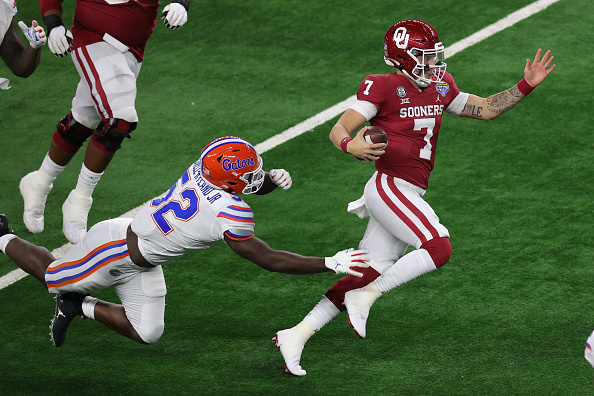Recently, there have been two massive dominoes to fall in the college football realignment scenarios. The founding members of the Big 12 in Texas and Oklahoma banded together and bolted for the Southeastern Conference. You just don’t have massive moves like this happening every day, so it gets one thinking, what if?
Imagine, if you will, the NCAA doesn’t lose its grip on collegiate sports and mandates the following:
- No Independents
- All ten conferences must have 13 schools
- Assign a promotion/relegation-style partnership between Power Five and Group of Five
In no way am I suggesting this will ever happen, nor do I have any inside information. This is only a thought experiment meant to pass the time. Obviously, this would never fly because you’d have to think of all of the other athletic programs at the school. But college football could be considered the best product of the American lifestyle, so why not stir it all up and muddy the waters?
College Football Realignment: Pie-In-The-Sky Scenario
Conference Partnerships
Most of the college football realignment centers around geographical locations and the respective success/failure of programs. In order to create ten conferences with 13 teams, two FCS programs will have to be called up: North Dakota State and James Madison. Eight of the last ten FCS titles belong to NDSU and one belongs to JMU. Each has dominated at the FCS level as of late and deserves their shot at the FBS level.
The conference partnerships for promotion and relegation are as follows:
Big 12 – Conference USA
SEC – Sun Belt
Big Ten – MAC
ACC – AAC
PAC 12 – Mountain West
Here is how this college football realignment would go: the bottom two teams in the Power Five conference standings would be relegated to the respective Group of Five conferences. Conversely, the top two in the G5 standings would be promoted.
Divisions would not remain. The top two teams, regardless of whether or not they played in the regular season, would play each other for the conference title. The CFP and its eventual expansion to 12 teams would have no bearing on these as all 130 teams will have their shot at winning it all (though we all know G5 teams don’t actually have a chance).
Big 12 – Conference USA
To start this college football realignment exercise, we must look at the conference who, in reality, will likely not survive.
Big 12 Teams
Baylor
TCU
Kansas
Kansas State
West Virginia
Iowa State
Oklahoma St
Texas Tech
North Dakota State (from FCS)
Cincinnati (from AAC)
Appalachian State (from Sun Belt)
Boise State (from MWC)
Texas A&M (from SEC)
Scrambling to remain relevant after dropping to eight teams, the Big 12 makes the biggest splashes by adding G5 powers Cincinnati, Boise State, and Appalachian State. Each of these programs has won wherever they play and would immediately compete. Additionally, they’d add the FCS power, NDSU. Geographically, NDSU is way north of anything, but they have played their way into the big leagues.
Where we have our first head-scratcher in this college football realignment is Texas A&M coming back. When Texas and Oklahoma joined the SEC, the schools voted 13-1 to allow it. The Aggies were that one and were not happy with UT trespassing on their golden goose. So they take their ball and go home and their old conference welcomes them back with open arms.
Conference USA Teams
Marshall
Florida Atlantic
Western Kentucky
Middle Tennessee State
Florida International
UT San Antonio
Louisiana Tech
North Texas
Rice
Southern Miss
UT El Paso
Houston (from AAC)
Texas State (from Sun Belt)
The additions to Conference USA are minimal, as they are a full conference as is. Adding Houston provides the conferences with another G5 program that has a winning history. Imagine that explosive Houston offense against a Big 12 defense. It’s very likely that these conferences would have also liked to add SMU, but they steal a different Texas school in Texas State.
The pairing of these two conferences is only natural. Geography aside, the two have a similar style of play and would certainly light up scoreboards on Saturdays.
SEC – Sun Belt
With the addition of Texas and Oklahoma, there is no denying the SEC is the strongest conference in the nation. You think it’s a gauntlet now, wait till you’re facing relegation because you have to run through Alabama, Georgia, Texas, Oklahoma, and at least two other overachieving teams like Florida or LSU.
SEC Teams
Alabama
Auburn
Tennessee
Florida
Kentucky
South Carolina
Texas
Oklahoma
Georgia
Missouri
LSU
Ole Miss
Mississippi State
Technically, the SEC doesn’t add anyone (we are assuming Texas and Oklahoma are established). Why should they? Unless they want to be greedy and poach a Clemson or Florida State, the SEC need not change.
Sun Belt Teams
Coastal Carolina
Georgia State
Georgia Southern
Troy
UL-Lafayette
Ul-Monroe
Southern Alabama
Arkansas State
Vanderbilt (relegated from SEC)
Liberty (from Independents)
Central Florida (from AAC)
UAB (from Conference USA)
SMU (from AAC)
The Sun Belt/Fun Belt only gets more fun. As is the theme thus far, the AAC gets raided and they steal the high-flying UCF and SMU programs. Add in the Hugh Freeze-led Liberty Flames and this conference gets really fun. UAB joins, further solidifying the SEC/Sun Belt Alabama stronghold. Poor Vanderbilt gets preemptively relegated from the SEC and will have to win its way back.
Unless something changes, the Sun Belt could just be sending two new teams for the SEC to railroad every year. Regardless, it would provide a little change and fun for falltimes in the south.
Big Ten – MAC
Overall, this pairing (in terms of moving teams) is the most boring college football realignment. The Big Ten and MAC occupy the same area in the country with a few outliers. One major change is the subtraction of Rutgers. Not sure you’re going to get a Big Ten team to argue to keep them.
Big Ten Teams
Ohio State
Michigan
Michigan State
Penn State
Maryland
Indiana
Illinois
Northwestern
Minnesota
Wisconsin
Purdue
Iowa
Nebraska
14 teams turn to 13 and all remains the same. Promotion/relegation or no, Ohio State still stands to dominate. After a few years, these two conferences could look very, very different. Will they ever change their name? There haven’t been only ten teams in the Big Ten since 1990.
MAC Teams
Buffalo
Kent State
Miami (OH)
Ohio
Akron
Bowling Green State
Ball State
Western Michigan
Central Michigan
Eastern Michigan
Toledo
Northern Illinois
Memphis (from AAC)
In the opposite direction as the Big Ten, the MAC goes from 12 to 13 with the addition of Memphis. With how cyclical and unpredictable the MAC is from year to year, adding Memphis just makes things that much more fun. Give me Memphis vs Toledo on a Tuesday in November! #MACtion
PAC 12 – MWC
Another no-brainer combination, the PAC 12 and Mountain West join forces. Just like the MAC, the PAC 12 just adds one team.
PAC 12 Teams
USC
UCLA
Arizona
Arizona State
Colorado
Stanford
Oregon
Oregon State
California
Washingon
Washington State
Utah
San Diego State (promoted from MWC)
When looking at the PAC-12 and MWC, adding San Diego State would be obvious. They are right there on the Pacific coast and have experienced some success. As you’d think, the PAC-12 tried to woo Boise State, but the power void left in the Big 12 was just too good to pass up.
MWC Teams
San Jose State
Nevada
Hawai’i
Fresno State
Air Force
Wyoming
New Mexico
Colorado State
Utah State
UNLV
New Mexico State (from Independents)
BYU (from Independents)
Tulsa (from AAC)
With the subtraction of its two best programs, the MWC brings back New Mexico State and BYU. The biggest concern of college football realignment (aside from travel distance) is preserving rivalries. With this partnership and potential for promotion for BYU, the Cougars will get to continue their Holy War with Utah.
ACC – AAC
As is the case with the Big Ten, the ACC has been a one-horse race for the past half-decade or more. Even if it was picked over, the AAC would provide an interesting bit of competition for the established ACC powers.
ACC Teams
Clemson
Wake Forest
North Carolina
Duke
Miami
Virginia
Virginia Tech
Louisville
Florida State
NC State
Pittsburgh
James Madison (from FCS)
Notre Dame (from Independents)
Notre Dame is already a de facto ACC program. They even joined the conference in 2020 in order to lock down a full schedule. All the Fighting Irish did was split with Clemson, make the ACC Championship Game, and earn a CFP berth. The inclusion of James Madison could be a bit outlandish, of course. Perhaps they should start off in the AAC so they can earn their way up. Regardless, the ACC remains intact.
AAC Teams
Navy
Tulane
Eastern Carolina
Temple
South Florida
Massachusettes (from Independents)
Army (from Independents)
Syracuse (relegated from ACC)
Boston College (relegated from ACC)
Georgia Tech (relegated from ACC)
Arkansas (from SEC)
Charlotte (from Conference USA)
Rutgers (from Big Ten)
Considering the AAC was the strongest of the G5, it was absolutely picked over and the top programs jumped at the opportunity to move up in the world. UMASS and Army join from the Independents. Now, the Army-Navy Game has even more stakes involved. Imagine they are playing for that second promotion spot…The ACC relegates Boston College, Syracuse, and Georiga Tech. None of these teams have been able to really find their footing recently, unfortunately. The SEC got Texas and Oklahoma, so they just decided to exile Arkansas. And Rutgers gets the boot from the Big Ten and is probably where it should be.
College Football Realignment is Fun!
Obviously, none of these scenarios would come to pass. There’s too much money and tradition involved. But it stands to reason that anything can happen. A promotion/relegation style of college football realignment would provide a way to spice up an already exciting game.
Considering the Texas/Oklahoma move will likely change the way college football looks, anything can happen. Considering the Big 12 is on thin ice, this could give them a way to remain respectable and not go the way of the WAC, Big East, SWC, etc. Teams can’t just mail it in during a bad year. Currently, if a team isn’t bowl-eligible, they coast into the off-season. With this, every game matters. You’re going to get some exhilarating late-season pillow fights to avoid relegation.
Main Photo:



